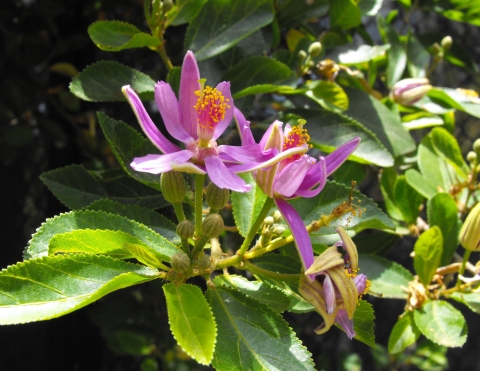Grewia caffra
Meisn.
Malvaceae
Grewia fruticetorum J.Drumm. ex Baker f.
Vincentia caffra (Meisn.) Burret
Vinticena caffra (Meisn.) Burret
Common Name:

Flowering stem
Photograph by: Stickpen
Public domain

Flowering stem
Photograph by: Stickpen
Public domain

Flowering plant
Photograph by: Bernard Dupont
Creative Commons 2 Share Adapt

Flowering branches
Photograph by: Bernard Dupont
Creative Commons 2 Share Adapt
General Information
Grewia caffra is a many-stemmed, deciduous shrub, often adopting a climbing habits. It can form thickets or scramble into other plants for support[
308- Title
- Flora Zambesiaca
- Publication
-
- Author
-
- Website
- http://apps.kew.org/efloras/fz/intro.html
- Publisher
-
- Year
- 0
- ISBN
-
- Description
- An excellent online flora of plants from the Zambezi River basin. It lists a number of the plant uses as well as the habitats and botanical descriptions of the plants.
].
The plant is harvested from the wild for local use as a food..
Known Hazards
None known
Botanical References
308- Title
- Flora Zambesiaca
- Publication
-
- Author
-
- Website
- http://apps.kew.org/efloras/fz/intro.html
- Publisher
-
- Year
- 0
- ISBN
-
- Description
- An excellent online flora of plants from the Zambezi River basin. It lists a number of the plant uses as well as the habitats and botanical descriptions of the plants.
Range
Southern Africa - Mozambique, S. Africa.
Habitat
Along banks of largish rivers; as a thicket-forming species or as a scrambler or liana in riverine fringes, usually at low elevations[
308- Title
- Flora Zambesiaca
- Publication
-
- Author
-
- Website
- http://apps.kew.org/efloras/fz/intro.html
- Publisher
-
- Year
- 0
- ISBN
-
- Description
- An excellent online flora of plants from the Zambezi River basin. It lists a number of the plant uses as well as the habitats and botanical descriptions of the plants.
].
Properties
| Edibility Rating |      |
| Habit | Deciduous Shrub |
| Height | 0.00 m |
| Cultivation Status | Wild |
Cultivation Details
Not known
Edible Uses
Fruit - raw or dried for later use[
308- Title
- Flora Zambesiaca
- Publication
-
- Author
-
- Website
- http://apps.kew.org/efloras/fz/intro.html
- Publisher
-
- Year
- 0
- ISBN
-
- Description
- An excellent online flora of plants from the Zambezi River basin. It lists a number of the plant uses as well as the habitats and botanical descriptions of the plants.
,
]. The fully ripe fruit is sweet to chew, even when dry[
301- Title
- Cornucopia II
- Publication
-
- Author
- Facciola. S.
- Publisher
- Kampong Publications, California.
- Year
- 1998
- ISBN
- 0-9628087-2-5
- Description
- The second edition of an excellent guide to the edible uses of plants, though it does not give any details of cultivation etc.
]. The yellow, globose fruit is 7 - 10mm in diameter[
308- Title
- Flora Zambesiaca
- Publication
-
- Author
-
- Website
- http://apps.kew.org/efloras/fz/intro.html
- Publisher
-
- Year
- 0
- ISBN
-
- Description
- An excellent online flora of plants from the Zambezi River basin. It lists a number of the plant uses as well as the habitats and botanical descriptions of the plants.
].
Leaves[
].
Medicinal
Grewia species are valued in many cultures for their medicinal virtues. The main medicinal action appears to come from the mucilage that is found in the leaves, stems and roots, which has been shown to have soothing and healing properties. Taken internally it is often used as a remedy for diarrhoea and dysentery, for example, whilst externally it is applied to wounds, cuts, ulcers, irritations etc. The plant can be taken as a simple infusion or decoction, or it can be applied topically as a poultice of the plant, or the mucilage can be extracted from the plant, if required, by maceration and then decoction.
We have no specific records for this species, but it is likely to have been used as a traditional medicine.
Other Uses
None known
Propagation
Seed - we have no specific information for this species but seed of this genus is generally best sown as soon as it is ripe. Stored seed has a hard seedcoat and may benefit from scarification before sowing in order to speed up and improve germination. This can usually be done by pouring a small amount of nearly boiling water on the seeds (being careful not to cook them!), allowing the mix to cool somewhat and then leaving it in a warm place to soak for 12 - 24 hours. Sow the seeds in situ or in a nursery seedbed or trays - do not allow the compost to become dry. Germination and early growth are usually quite quick.
Cuttings - best taken with a heel.
If you have any useful information about this plant, please leave a comment. Comments have to be approved before they are shown here.
 Useful Tropical Plants Database 2014 by
Ken Fern,
web interface by
Ajna Fern
with help from
Richard Morris.
Useful Tropical Plants Database 2014 by
Ken Fern,
web interface by
Ajna Fern
with help from
Richard Morris.